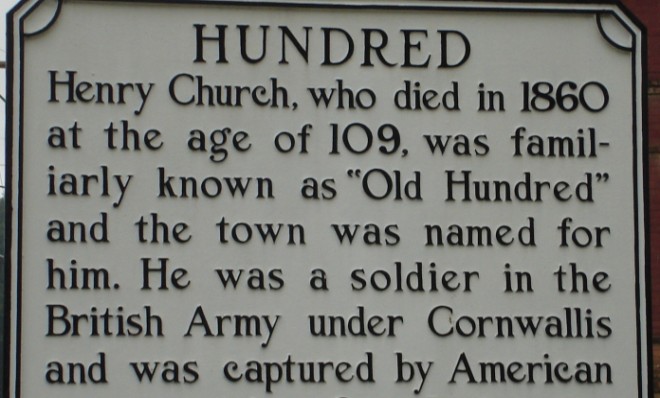8 towns whose names are numbers
Hundred, West Virginia is a real place. So is Fifty-Six, Arkansas


1. HUNDRED, WEST VIRGINIA
Hundred, West Virginia was founded by Henry Church, one of its earliest settlers. Church was born in 1750 and was sent to America to help put down the colonies' rebellion. After the Revolutionary War, he elected to stay, and built a cabin in West Virginia along with his new wife, who he met in America. Church stayed at his farm until he died in 1860 at the age of 109 (shortly after his wife died at 106). Locals called this first inhabitant of the area "Old Hundred," and the town took on that name in his honor. The post office was established in 1886, and was named simply Hundred.
2. FIFTY-SIX, ARKANSAS
The Week
Escape your echo chamber. Get the facts behind the news, plus analysis from multiple perspectives.

Sign up for The Week's Free Newsletters
From our morning news briefing to a weekly Good News Newsletter, get the best of The Week delivered directly to your inbox.
From our morning news briefing to a weekly Good News Newsletter, get the best of The Week delivered directly to your inbox.
Fifty-Six is a town of 163 people in Stone County, Arkansas. In the 1920s, Reva Newcomb opened a general store and applied to establish a post office in the community. He requested the name Pleasant Hill, but since that name was already used in Arkansas, the postal service responded by approving his second-choice name, which was Fifty-Six, the number of the school district. Fifty-Six is nestled in the Ozarks, and offers several tourist stops, such as Blanchard Springs Caverns and Mirror Lake.
3. NINETY SIX, SOUTH CAROLINA
The town of Ninety Six, South Carolina, dates at least to 1730, the earliest documentation of a general store, which served traders traveling to Cherokee country. The name is thought to have been derived from a surveyor's estimate that the town was 96 miles from Keowee, an important Cherokee community. A fort was built at Ninety Six in 1775 to defend the community from the British. The British took the town, built a new fort in a star shape, and held it until 1781, when they left and burned the community behind them. In 1783, a new Ninety Six was built next to the ruined fort. The location of the original Ninety Six fort and the Star Fort are now designated as a National Historic Site.
4. TWENTYSIX, KENTUCKY
A free daily email with the biggest news stories of the day – and the best features from TheWeek.com
Twentysix is an unincorporated community in Morgan County, Kentucky. The story is that the community's first postmaster, Martha Rowland, submitted 25 possible community names, and then jotted down "26," which was the year she submitted the list — 1926. The post office was officially established in 1927, and closed in 1957.
5. EIGHTY-EIGHT, KENTUCKY
The town of Eighty-Eight, Kentucky, is in Barren County, near Glasgow. It was named in 1860 by postmaster Dabnie Nunnally, who figured that "88" would be readable even in his own bad handwriting. The number came from the amount of change in his pocket. In the 1948 presidential election, the community reported 88 votes for Truman and 88 votes for Dewey, which earned it a spot in Ripley's Believe It or Not. Then in 1988, postmistress Donnie Sue Bacon noticed an increasing number of letters were being sent for the purpose of having them stamped with the Eighty-Eight postmark. The community took advantage of the special year and had a celebration on August 8, 1988. A parade (held the day before, as 8/8/88 was a Monday) was led by a child who would turn eight on 8/8/88, and the grand marshall was 88-year-old Eighty-Eight resident Elsie Billingsley. A couple drove in from Wyoming to be married in the community at 8:08 PM on 8/8/88.
6. SEVENTY-SIX, KENTUCKY
The town of Seventy-Six, Kentucky, was named for nearby Seventy-Six Falls, on Lake Cumberland. Seventy-Six Falls is actually easier to reach by boat than by road. The number has nothing to do with the height or width of the falls, but was the designation on a surveyor's notes for the nearby station number. The town was settled in 1806 when John W. Semple built a grist mill, and later a general store. The small town thrived for about 100 years, and then began a long decline. The mill burned in 1943, and the area is now a park.
7. EIGHTY FOUR, PENNSYLVANIA
Eighty Four, Pennsylvania, is a community of over 600 people about 25 miles southwest of Pittsburgh. The community was originally called Smithville, but there was another Smithville in Pennsylvania. The local postmaster selected Eighty Four as a new name because the year was 1884. Or it could have also been named after a local railroad mile marker. Other stories about the name abound, like the one where settlers killed 84 marauding Indians, or that only 84 settlers survived a bad winter. The most likely explanation is the postmaster who "just didn't have a whole lot of imagination." Eighty Four was the birthplace of 84 Lumber, the largest privately-held building materials chain in the U.S.
8. SIXES, OREGON
The town of Sixes, in Curry County, Oregon, is named for the Sixes River. The consensus is that the river was named Sixes as an English corruption of a Native American term, but which was the original term? It may have been "sikhs," meaning "friend," or "Sa-qua-mi," which is thought by some to be the original native name of the river (early maps label it the "Sequalchin River"), or maybe it was "Sik-ses-tene," the name of a local tribe.
More from Mental Floss...
* 10 loud places that are actually nice and quiet

